Foreword
While two-thirds of this collection of Dow Industrials is too pricey and reveals only skinny dividends, two of the five lowest-priced Dogs of the Dow are ready to buy. This month, Verizon Communications (VZ) and Walgreens Boots Alliance (WBA) live up to the dogcatcher ideal of annual dividends from $1K invested exceeding their single share prices.
However, seven more, Dow (DOW), 3M Company (MMM), Cisco (CSCO), Coca-Cola (KO), International Business Machines (IBM), Chevron (CVX), and Amgen (AMGN), showed prices within 64% of meeting that goal. Another one, The Goldman Sachs Group (GS) needs prices to drop near 68% before that offering reaches the dogcatcher ideal level.
With renewed downside market pressure of 68%, it would be possible for all ten to become elite fair-priced dogs with their annual yield (from $1K invested) meeting or exceeding their single share prices by year’s end.
Actionable Conclusions (1-10): Brokers Expect 17.91% To 33.3% Net Gains From Top-Ten Dow Dogs By September 2024
Four of the ten top dividend-yielding Dow dogs (tinted gray in the chart below) were among the top ten gainers for the coming year based on analyst 1-year target prices. So, this September 2023 yield-based forecast for Dow dogs, as graded by Wall St. wizard estimates, was 40% accurate.
Estimated dividend returns from $1,000 invested in the ten highest-yielding stocks and their aggregate one-year analyst median target prices, as reported by YCharts, created the 2023-24 data points for the projections below. (Note: one-year target prices estimated by lone analysts were not applied.) Ten probable profit-generating trades projected for September 2024 were:
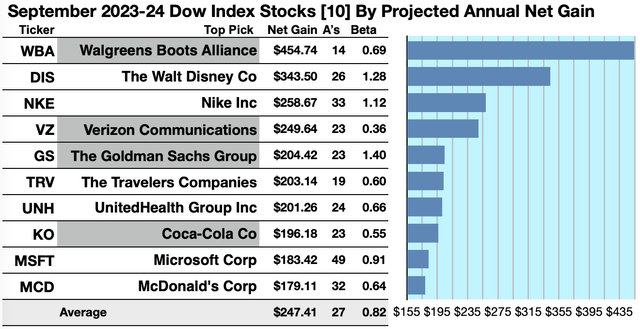
Source: YCharts.com
Walgreens Boots Alliance was projected to net $454.74, based on the median of target prices estimated by 14 analysts, less broker fees. The Beta number showed this estimate subject to risk/volatility 31% less than the market as a whole.
The Walt Disney (DIS) was projected to net $343.50, based on the median of target price estimates from 26 analysts, less broker fees. The Beta number showed this estimate subject to risk/volatility 28% greater than the market as a whole.
Nike (NKE) was projected to net $258.67, based on dividends, plus the median of target price estimates from 33 analysts, less broker fees. The Beta number showed this estimate subject to risk/volatility 12% greater than the market as a whole.
Verizon Communications was projected to net $249.64, based on dividends, plus the median of target price estimates from 23 analysts, less broker fees. The Beta number showed this estimate subject to risk/volatility 64% less than the market as a whole.
The Goldman Sachs Group was projected to net $204.42, based on the median of target price estimates from 23 analysts, plus the estimated annual dividend, less broker fees. The Beta number showed this estimate subject to risk/volatility 40% greater than the market as a whole.
The Travelers Companies (TRV) was projected to net $203.14, based on dividends, plus median target price estimates from 19 analysts, less broker fees. The Beta number showed this estimate subject to risk/volatility 40% less than the market as a whole.
UnitedHealth Group (UNH) netted $201.26 based on the median of target price estimates from 24 analysts, less broker fees. The Beta number showed this estimate subject to risk/volatility 34% less than the market as a whole.
Coca-Cola was projected to net $196.18 based on the median of target price estimates from 23 analysts, plus dividends, less broker fees. The Beta number showed this estimate subject to risk/volatility 45% less than the market as a whole.
Microsoft (MSFT) was projected to net $183.42, based on dividends, plus the median of target price estimates from 49 analysts, less broker fees. The Beta number showed this estimate subject to risk/volatility 9% less than the market as a whole.
McDonald’s (MCD) was projected to net $179.11, based on dividends, plus the median of target price estimates from 32 analysts, less broker fees. The Beta number showed this estimate subject to risk/volatility 36% less than the market as a whole.
The average net gain in dividend and price was estimated at 24.74% on $10k invested as $1k in each of these top ten Dow Index stocks. This gain estimate was subject to average risk/volatility 18% less than the market as a whole.
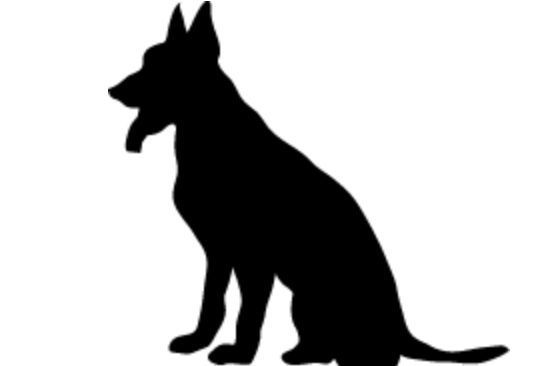
Source: Open source dog art from dividenddogcatcher.com
The Dividend Dogs Rule
Stocks earned the “dog” moniker by exhibiting three traits: (1) paying reliable, repeating dividends, (2) their prices fell to where (3) yield (dividend/price) grew higher than their peers. Thus, the highest yielding stocks in any collection became known as “dogs.” More precisely, these are, in fact, best called, “underdogs”.
The September 2023 Dow 30 By Yield
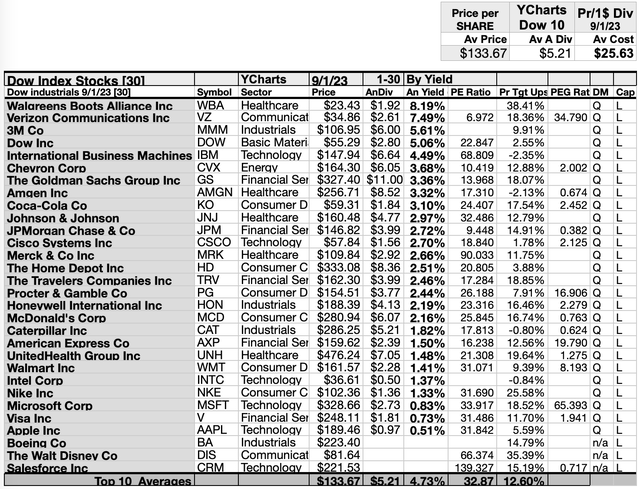
Source: YCharts.com
Actionable Conclusions (11-20): 10 Top Dow Dividend Stocks By Yield Ranged 2.97% To 8.19% Per YCharts
Top ten Dow dogs as of 9/1/23 represented eight of eleven Morningstar sectors.
The first of three healthcare stocks placed first, Walgreens Boots Alliance [1]. The others fell into eighth and tenth places, Amgen [8] and Johnson & Johnson (JNJ) [10].
There followed the lone communication services sector member in second place, Verizon [2]. Then, a lone industrials dog was third, 3M [3]. In fourth place was the lone basic materials dog, Dow [4].
A Technology sector dog took the fifth position, International Business Machines [5]. Another loner from the energy sector was sixth, Chevron [6].
Seventh place belonged to the financial services representative, The Goldman Sachs Group [7], and finally, in ninth, the consumer defensive stalwart, Coca-Cola [9] completed the September Dogs of the Dow by yield.
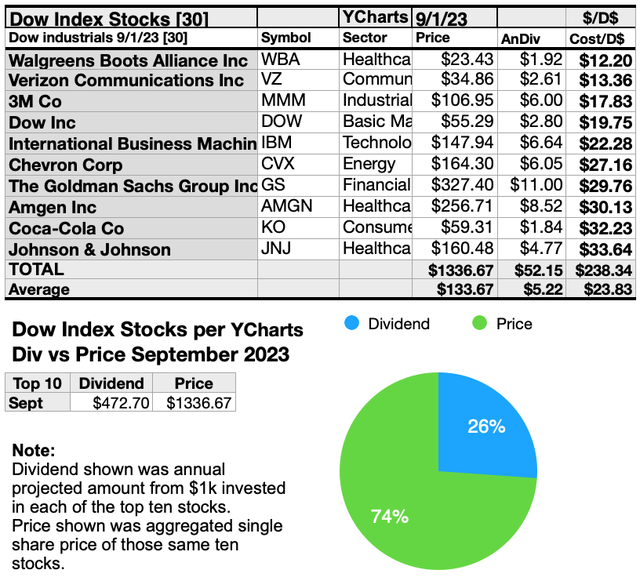
Source: YCharts.com
Dividend Vs. Price Results
The graph above shows the relative strengths of the top ten Dow dogs by dividend and price as of the market close 9/1/2023.
This month, eight of the top-ten Dow dogs show a less-than-ideal status because the prices of those eight exceed projected annual dividends from $10k invested (as $1k each). A dividend dogcatcher priority is to select stocks whose dividends from $1K invested are greater than their single share price. As mentioned above, that condition was reached by two of the five lowest-priced Dogs of the Dow. Verizon Communications and Walgreens Boots Alliance, both live up to the dogcatcher ideal of annual dividends from $1K invested exceeding their single share prices. Furthermore, seven more showed prices within $164.41 of meeting that ideal goal as of September 1. Those seven outliers are: Amgen, $164.41 off the mark; Johnson & Johnson, $91.42 behind; Chevron, $86.52 back; International Business Machines, $66.46 away, 3M, $29.49 off goal; Coca-Cola, $17.82 out; and Dow $2.38 below the mark.
Actionable Conclusion (21): Three of Twenty-Seven Dow Dividend Dogs Are Overbought
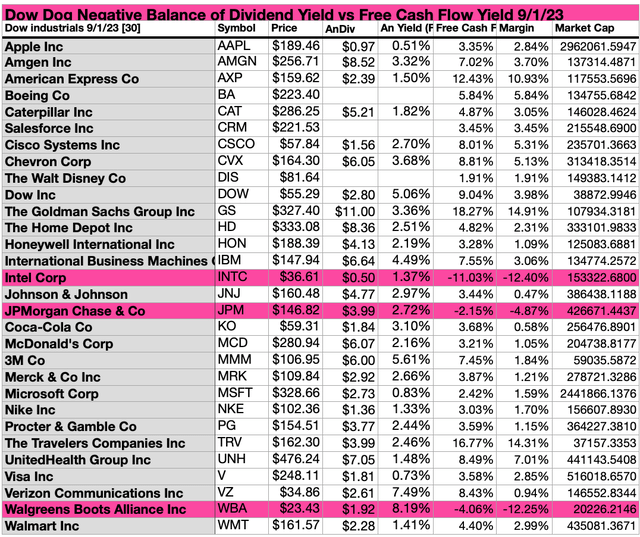
Source: YCharts.com
A negative gap between dividend yield and free cash flow yield defines an overbought (or oversold) stock. That is, their dividend payout exceeds their cash on hand to pay dividends. The three are Intel (INTC), JPMorgan Chase & Co. (JPM), and Walgreens Boots Alliance.
Two cut their dividends in the 2020 Ides of March depression times, Boeing (BA) and The Walt Disney (DIS). One more snuck onto the Dow index without a dividend, the newest of the three no-dividend stocks in the index, Salesforce (CRM). All six, three short on cash and three non-dividend payers, are not stockholder friendly.
Remember this dogcatcher yield-based stock-picking strategy is contrarian. That means rooting for (buying) the underdog is productive when you don’t already own these stocks. If you do hold these stocks, then you must look for opportune pull-backs in price to add to your position to best improve your dividend yield. Plenty of pull-back opportunities appear to be ahead.
Price Drops or Dividend Increases Could Get All Ten Dow Dogs Back to “Fair Price” Rates For Investors
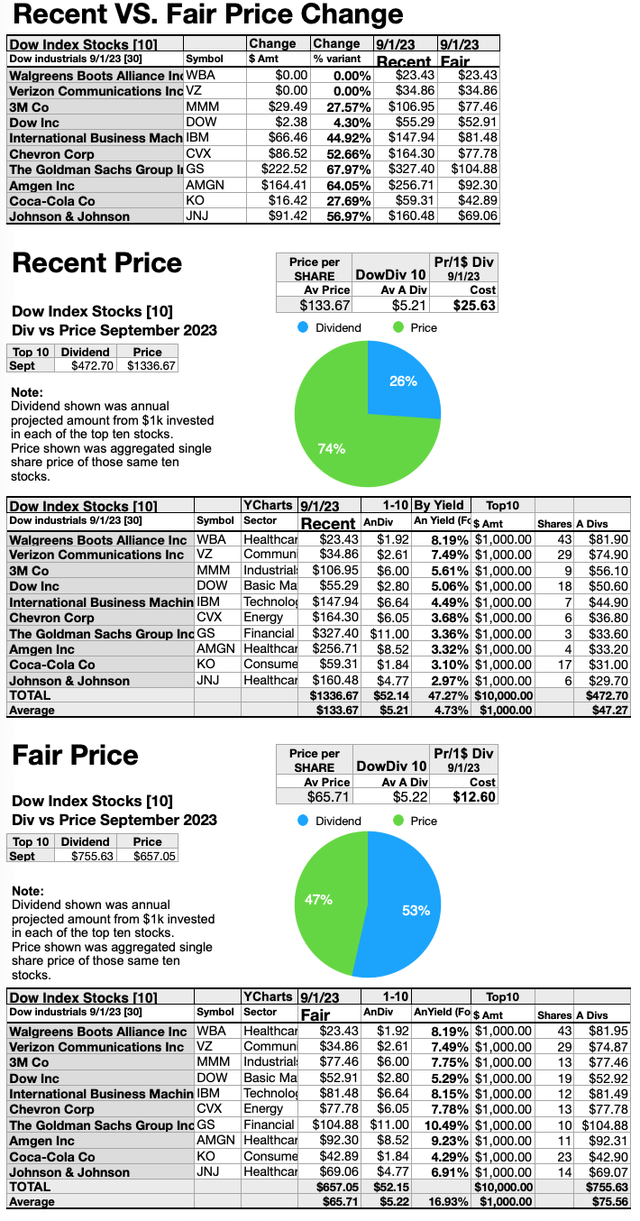
Source: YCharts.com
The charts above retain the current dividend amount and adjust the share price to produce a yield (from $1K invested) to equal or exceed the single share price of each stock. As the top illustration shows, two are ideally priced. Besides Verizon Communications and Walgreens Boots Alliance, already in the ideal zone, seven more low-priced stocks are within $164.41 of getting there as noted above.
The alternative, of course, could be that these companies raise their dividends. That, however, appears to be too much to ask in these highly disrupted, inflationary, recessionary, yet cash-rich times. Mr. Market is much more effective at moving prices up or down to appropriate amounts, just watch and buy when the targeted stock price moves to a sweet spot.
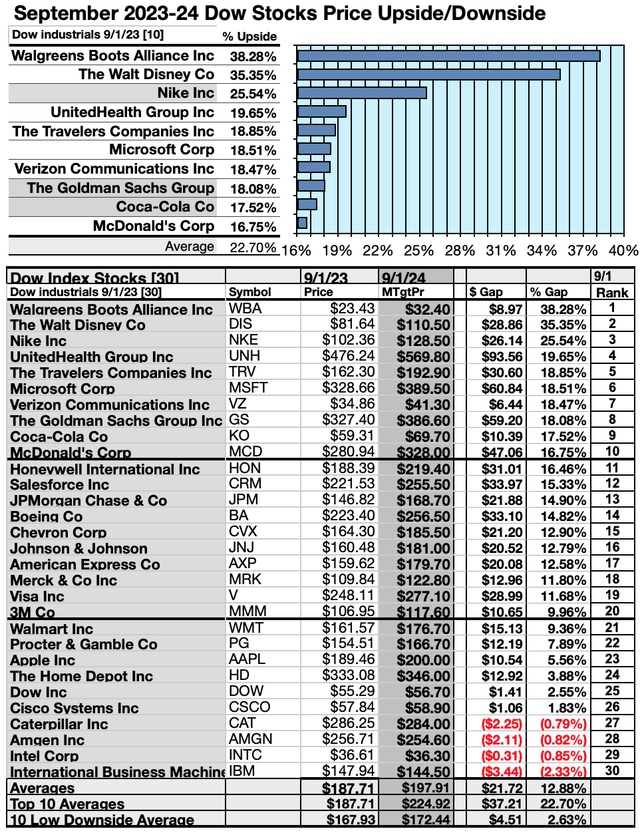
Source: YCharts.com
Actionable Conclusions: (22-31) Broker 1-Yr. Targets Showed 16.75% To 38.28% Top Ten Dow Index Upsides To September 2024; (32) Four -0.79% to -2.33% Downsiders Were Counted
To quantify top dog rankings, analyst median price target estimates provided a “market sentiment” gauge of upside potential. Added to the simple high-yield “dog” metrics, analyst median price target estimates provided another tool to dig out bargains.
Analysts Forecast A 35.09% Advantage For 5 Highest-Yield, Lowest-Priced of 10 Dow Dogs As Of September 1, 2024
Ten top Dow dogs were culled by yield for their monthly update. Yield (dividend/price) results as verified by YCharts did the ranking.

Source: YCharts.com
As noted above, top-ten Dow dogs selected 9/1/23 by yield represented eight of the eleven sectors. The Consumer Cyclical sector went missing. (Real Estate is not reported and Utilities has its own Dow Index.)
Actionable Conclusions: Analysts Expected 5 Lowest-Priced of the Ten Highest-Yield Dow Dogs (34) To Deliver 22.25% Vs. (35) 16.47% Net Gains by All Ten Come September 1, 2024

Source: YCharts.com
$5,000 invested as $1k in each of the five lowest-priced stocks in the top ten Dow Dividend kennel by yield were predicted by analyst 1-year targets to deliver 35.09% more gain than from $5,000 invested in all ten. The very lowest-priced top ten yielding stock, Walgreens Boots Alliance, showed top analyst-estimated gains of 45.47%.
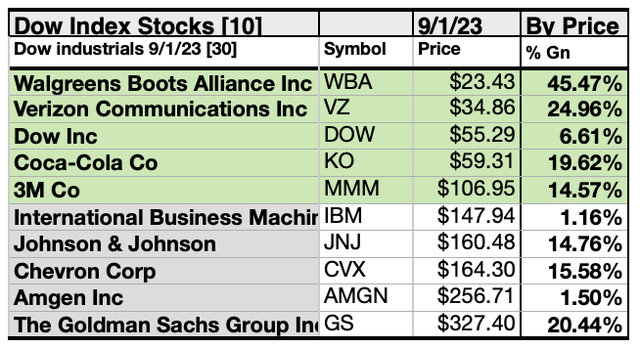
Source: YCharts.com
The five lowest-priced Dow top-yield dogs for September 1 were: Walgreens Boots Alliance; Verizon Communications; Dow; Coca-Cola; 3M, with prices ranging from $23.43 to $106.95.
Five higher-priced Dow top-yield dogs as of September 1 were: International Business Machines; Johnson & Johnson; Chevron; Amgen; The Goldman Sachs Group, whose prices ranged from $147.94 to $327.40.
The distinction between five low-priced dividend dogs and the general field of ten reflected Michael B. O’Higgins’ “basic method” for beating the Dow. The scale of projected gains based on analyst targets added a unique element of “market sentiment” gauging upside potential. It provided a here-and-now equivalent of waiting a year to find out what might happen in the market.
Caution is advised since analysts are historically only 15% to 85% accurate on the direction of change and just 0% to 15% accurate on the degree of change. (In 2017, the market somewhat followed analyst sentiment. In 2018, analysts’ estimates were contrarian indicators of market performance, and they continued to be contrary for the first two quarters of 2019 but switched to conforming for the last two quarters.) In 2020, analyst projections were quite contrarian.
In the first half of 2021, most dividend stock price actions exceeded all analyst expectations. The last half of 2021 was still gangbusters. The 2022 September-December slump freed up five or more Dow dogs, sending them into the ideal zone where returns from $1k invested equal (or exceed) their single-share price.
As the Fed-fueled slide gains momentum in 2023, look for most of the ten Dow Dogs to become Fair-priced… slowly, but surely.
Afterword
Lest there be any doubt about the recommendations in this article, this month there were two Dow Index stocks showing dividends (from $1k invested) exceeding single share price: Verizon Communications and Walgreens Boots Alliance. However, Walgreens is overbought with dividend yield exceeding free cash flow yield. Two other overbought Dow Index members are Intel and JPMorgan Chase.
The dogcatcher hands-off recommendations are still in place referring to three non-dividend paying suspects. One that cut its dividend in March 2020 Boeing has re-learned (and is certified in certain countries) to fly, but it still has to coax customers to buy planes again. BA faces strong headwinds to stay on the Dow index (despite analyst optimism for the lone U.S. commercial air-crafter).
Also keep hands-off the newest non-dividend member of the Dow, Salesforce, Inc., until it declares a dividend from $1K invested greater than its single share price, perhaps new leadership will help.
While subscriptions keep the ship afloat, Disney needs audiences to get strapped back into buying tickets to watch and ride and will likely never resume a dividend. Meanwhile, DIS has Apple, Amazon, Netflix, and Paramount, TikTok, and numerous other content providers pouring out streamable content once the writers and actors get the demands for which they went on strike. Will the mouse house ever roar again, let alone, pay dividends?
The net gain/loss estimates above did not factor in any foreign or domestic tax problems resulting from distributions. Consult your tax advisor regarding the source and consequences of “dividends” from any investment.
Stocks listed above were suggested only as possible reference points for your Dow dividend dog stock purchase or sale research process. These were not recommendations.
Read the full article here












Leave a Reply